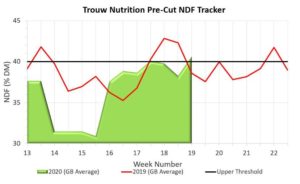An increase in grass growth has been experienced with the North East seeing the highest levels at 68kg DM/ha/day and Yorkshire with the lowest rates at 51kg DM/ha/day. The largest change in grass growth was seen in the East with an average increase of 15kg DM/ha/day.
Averaging at M+14.26 litres/day, the potential MYFG has increased M+4.74 litres/day on the week. This figure is greater than last years for the same period (M+13.41 litres/day) and the 6-year average (M+12.65). This increase in MYFG can be attributed to the 2.14kg/day increase in potential grass dry matter intake. The highest MYFG, at M+21.8 litres/day was seen in Scotland, where the North West saw lowest at M+1.2 litres/day. However, take into the consideration that these figures were taken from a relatively small data set.
Butterfat depression risk remains, with acid load and Rapidly Fermentable Carbohydrates (RFC) levels remaining high. It is important to put in place strategies to avoid a low rumen pH (if farmers have not already done so). Providing rumen buffers within the diet can provide effective buffer capacities. A potential loss of just under half a litre was reported last week due to excess nitrogen. Consider adding sources of fermentable energy into the diet, to help utilise this excess and the addition of NWF Opti Rumen to help protein efficiency.
Growing Cattle
For growing cattle, a minimum target growth rate should be a 1kg/head/day. Measuring grass growth, ensuring that there is adequate DM available to growing cattle is key to optimising growth performance at grass.
Mg Deficiencies
Combining increased intakes of rumen degradable protein and potassium from rapidly growing, lush spring grass presents a significant threat of magnesium deficiency. Providing supplementary sources of Mg, to ensure requirements are met can help mitigate this. There are several ways to supplement Mg, depending on the system. These include compound feed, in-feed and free-access powdered mineral, Mg bolus, lick buckets and blocks and Mg in water.
Pre-Cut NDF Tracker
Just under 300 pre-cut samples were received by Trouw’s lab during the latest period which helps increase the accuracy of pre-cut NDF development reporting. The average NDF content of these is 39.23%, whilst first cuts appear to be behind last year, this highlights that there is still an opportunity to cut at the NDF threshold of 38-40% for optimum quality. As many farmers will be getting underway with first cuts and pre-cut samples continue to flood into the lab, bi-weekly updates on pre-cut NDF develop will continue to help guide on-farm decisions.
